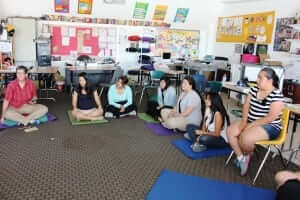Caren McDonald teaches English at East Palo Alto Academy High School, an ethnically diverse community. Many parents are undocumented and low-income, with low literacy levels. She has worked to establish mindfulness in the school in a number of ways, including weekly lessons with the ninth grade in advisory, two elective classes for upperclassmen, and frequent opportunities to practice in her English classes. Caren was recently successful in establishing a mindfulness curriculum that meets the “G” requirement in the California Department of Education standards.

When her son was in kindergarten, he playfully kissed a boy on the lips. His teacher shamed him for this. After that, the boy stopped hugging and kissing everyone in his life, even his mother. She felt rejected by her son, and tried for years to get him to become affectionate again. But after spending an entire year in my mindfulness class, her son finally hugged her, and he has since become more affectionate.
She cried as she continued. “After ten years of not hugging anyone, not even me, his own mother, he has finally started to become affectionate again. This is because of your mindfulness class. Thank you and God bless you.” As we both cried, she hugged me and thanked me over and over.
This student was in my class three days a week. We sat 10 minutes a day, and did yoga 20-30 minutes a week. Students kept a gratitude journal every week, had Socratic seminars on healthy speech, healthy attitudes, and lots of other activities, including a class discussion about gender stereotypes, where we discussed how it’s okay and healthy for boys to have intimate friendships with each other.
I recalled how that young man had twitched his legs and looked around nervously when we practiced our mindful breathing. But gradually, we normalized practicing. Sure, it felt “weird” to everyone at first, but as we all accepted the class, a sweet friendliness grew. Slowly but surely, all the students felt safe. After that ELAC meeting, I realized how much he had changed; because he stuck to it, his heart opened up.
This is what a mindfulness class can produce. A community of mindfulness practitioners can create a unique level of intimacy, whether it’s in a classroom or a meditation hall. When fostered and monitored by an empathic facilitator, that intimacy creates a richer classroom, even a healthier world. Mindfulness practice in school isn’t merely about improved grades, attendance, or behavior; the benefits can be self-awareness, a more open heart, and better relationships with family and friends. It’s subtle stuff, this mindfulness—a slow, glacial thawing of trauma.
When I see that student bear-hugging his friends on campus this year, I know that at least one heart has thawed out, and is warming up the world around him.
Caren graduated from our Year-Long Certification Program in 2015. She wrote an in-depth commentary on mindfulness for high school students in Green Teacher and was interviewed with a student from her high school by the Huffington Post. She tweets @carenmcdonald and may be reached at carenmcdonald@gmail.com.
